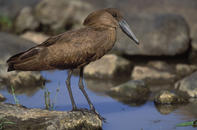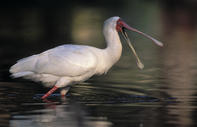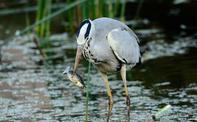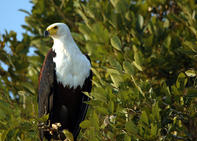Hamerkop

The hamerkop specialises in eating frogs and tadpoles particularly platannas. They do this by wading in shallow water stirring the mud below with their feet and probing in the water with their sturdy bills until a frog moves, giving itself away at which point it is snapped up.
Hamerkops do also eat a small amount of fish and invertebrates and occasionally forage by snatching evident morsels from the surface of water while in flight.
African Spoonbills

Ducks and Geese

Ducks have flat bills which are used for sieving edible particles out of the water. Many ducks up-end or dabble, partially submerging their upper bodies in order to access food below the water.
The food they consume includes various parts of aquatic plants, insects, detritus in mud, algae, crustaceans and other invertebrates.
White-faced ducks dabble for food but may also dive fully under the water to obtain something they desire. They are fairly unique among ducks for their tendency to also feed at night on grass, seeds, grain and even fruit. The characteristic 3-syllabled whistle makes these attractive ducks easy to recognise in flight.
hey are often heard in the evenings as they fly over on their way to forage. Egyptian geese are true grazers flying to open areas to feed on grass, seeds and grain, leaves and even young crops early in the morning or late afternoon.
Herons

African Fish Eagle

The fish eagle is a piscivore (fish-eater) and is specialised for this difficult task. It has long sharp talons to effect a tight grip on its slippery quarry as well as spicules under the feet which also assist with grip.
Typically the fish eagle will remain perched for most of the day hunting for only 1% of its time. On sighting a fish or possibly a swimming reptile (like a monitor lizard, snake or terrapin) it will stoop down off its perch and plane low over the water and then throwing its talons forward it will snatch up the prey off the surface in a well-executed single movement. It never dives deeper than 30cm and prey of 2kg is easily carried away.
Larger fish are caught but must be planed or paddled to the shore. Fish eagles do take other food including birds, mammals, reptiles and occasionally frogs and they are particularly accomplished pirates (especially the younger birds) robbing other birds of their food or harassing birds like herons until they disgorge their crop contents.
Like marabou storks, fish eagles monopolise drying pools for the trapped fish. They are also astute nest-robbers pulling weavers nests to shreds to get at the nestlings.
By Megan Emmett